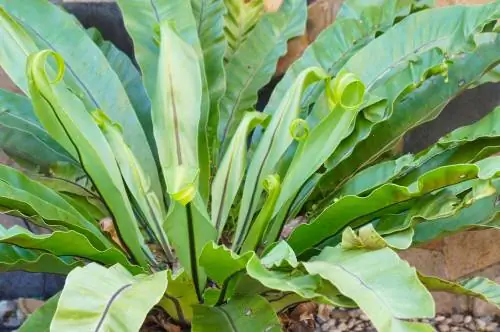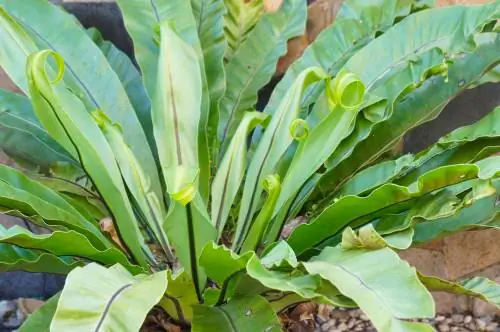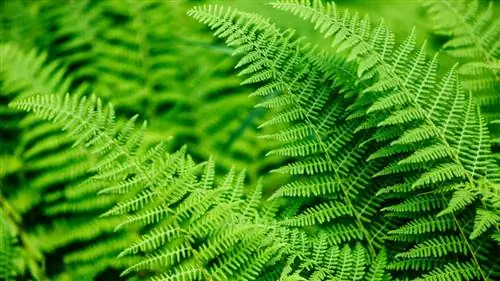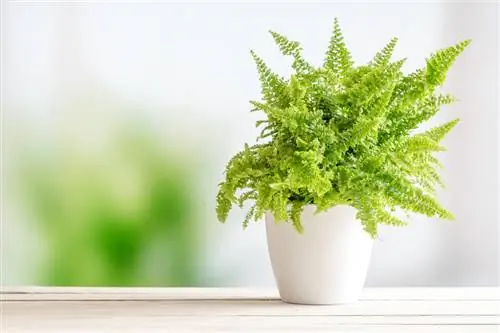- Author admin [email protected].
- Public 2023-12-16 16:46.
- Last modified 2025-01-23 11:21.
The nest fern (bot. Asplenium nidus) decorates the home with bright green fronds arranged in lush rosettes that become more impressive with age. The ornamental leaf plant is suitable as an uncomplicated house and container plant that also finds a suitable place on the balcony or terrace during the summer months. You can find out how to properly care for this pretty plant in this article.

How do you optimally care for a nest fern?
The nest fern (Asplenium nidus) is an easy-care houseplant with lush, green fern fronds. It prefers partially shaded locations, high humidity and should be planted in a low-lime, permeable substrate. Regular watering without waterlogging, occasional fertilization and repotting every 2-3 years support its growth.
Origin and distribution
The nest fern (bot. Asplenium nidus) is a species of fern from the striped fern family (bot. Aspleniaceae), which was widespread in prehistoric times. The house and container plant, which is popular with us because of its simplicity and its stately, green tuft of leaves, comes from the tropical regions of Asia, Australia and Africa, where it grows as an epiphyte on trees (bot. epiphyte) or rocks (bot. lithophyte). occurs very frequently. The nest fern is one of the most important habitats for many tree-dwelling frog species, as the amphibians find the moist and cool microclimate they need in the frond funnels.
Appearance and growth
The nest fern, which grows epiphytically in its natural environment, can reach considerable sizes and is often between 90 and 100 centimeters high even when grown indoors. The plant develops a dense rosette of strong green leaves, the so-called fern fronds, which grow from a strong, woody rhizome. In addition to the fronds, the rhizome also has numerous aerial roots that can form a dense tangle. Nest ferns initially grow more upright, but the longer and longer leaves droop slightly as they get older.
leaves
The long, wavy leaves of the nest fern arise from a funnel-shaped, basal rosette and grow more or less upright. The nest-shaped leaf funnel has an important function for the nest fern because both rainwater and plant residues collect here. These ensure that the plant is supplied with moisture and nutrients. The lanceolate leaves can be up to 120 centimeters long and up to 30 centimeters wide.
Flowers, flowering time and fruits
Like all ferns, the nest fern does not produce flowers and is therefore purely a foliage plant. However, Asplenium nidus reproduces itself through spores that sit in groups in elongated spore beds on the undersides of the long leaves to the right and left of the midrib.
Toxicity
Nest fern - like almost all real ferns - is considered non-toxic. In some Asian regions, for example in the mountainous regions of Taiwan, the leaves are even traditionally prepared as a vegetable.
Which location is suitable?
Botanically speaking, ferns - and therefore also the nest fern - are shade plants. However, this does not mean that they can function completely without light. In its natural location, the nest fern thrives in the protection of the tall jungle trees, but still receives sufficient sunlight for its lush growth. The plant feels most comfortable in partial shade or light shade, but direct sun should be avoided - this causes burns to the delicate fern fronds. A spot by a north-facing window is perfect. The plant also feels comfortable in the bathroom due to the high humidity it requires. Keep the humidity high all year round to at least 60 percent, preferably up to 80 percent, and ensure warm temperatures between 18 and 25 degrees Celsius. The nest fern also cannot tolerate drafts.
Substrate
When it comes to the right substrate, nest ferns are not quite as demanding. In principle, the plant thrives in all commercially available potting soil, as long as it contains humus instead of peat and is mixed with expanded clay granules, gravel or sand to improve permeability. You should also add a layer of expanded clay or gravel to the bottom of the pot for better drainage. Since the nest fern, like many tropical orchid species, is an epiphytic species, you can also plant the plant in coarse orchid soil.
Planting and repotting
Since the nest fern grows quite slowly and does not develop a strong root system, you only have to repot it into new soil every two to three years - exception: you water the plant with lime-containing tap water, then annual repotting into fresh substrate is recommended. Like other epiphytes, the nest fern is very sensitive to lime. A larger plant pot, on the other hand, is only necessary if the fine roots are already growing out of the old container. The new pot shouldn't be too big, one size larger than the old one is sufficient.
When planting and repotting, remove as much of the old, used substrate as possible and sterilize the new one in the oven (30 minutes at 150 degrees Celsius) or in the microwave (10 minutes at 800) to protect against pests and pathogens Watt). Also avoid using a planter and place the planter on a bowl filled with stones and water to increase the humidity.
Watering the nest fern
As a typical rainforest plant, the root ball of the nest fern should always be kept slightly moist, but never wet - the plant, which is sensitive to this, cannot tolerate waterlogging at all. It is better to let the substrate dry out slightly before watering or diving again. Especially during the warm summer months, the nest fern often needs a lot of water and can therefore occasionally be dipped into a bucket of water with its root ball. Also pay attention to these instructions when watering:
- If possible, only use low-lime water.
- Filtered or well-stale tap water or rainwater are suitable.
- Normal tap water can also be used.
- Then, however, it must be repotted annually into fresh substrate.
- Otherwise, deficiency symptoms will occur.
- Always water with room temperature water, never with cold water.
Also make sure to always water from below and directly onto the substrate; the sensitive fern fronds should not be wetted.
Spraying
In the rainforest, the humidity is naturally very high. So that the nest fern feels comfortable in your living room, you should create similar conditions there. Simple methods are suitable for this and are to be used especially during the winter heating period (and the associated dry room air):
- Place a humidifier.
- Install an indoor fountain.
- You can easily build this yourself.
- Set up bowls filled with gravel or gemstones and water.
- Place the plant pot on such a stone bowl instead of in a planter.
- This bowl should be larger than the pot so that the water can evaporate.
- However, the roots of the nest fern must never be in water.
Many tropical houseplants should be sprayed regularly with a fine mist to keep the humidity high. However, you should avoid this with the nest fern, as the sensitive leaves cannot tolerate such treatment and will subsequently develop unsightly brown spots.
Fertilize the nest fern properly
In the first year after repotting or if it is transferred annually to fresh substrate, regular fertilization of the nest fern is not necessary. Only from the second year onwards do you provide the plant with a liquid, low-dose green plant fertilizer between April and September, which you should ideally give together with the irrigation water. One dose every two to three weeks is completely sufficient. During the second half of the year you either fertilize very lightly every six to eight weeks or not at all.
Cut the nest fern correctly
Regular pruning is neither necessary nor useful for nest ferns. You shouldn't want to limit the size or circumference of the plant with the help of scissors, as this will leave an unevenly shaped leaf funnel. Only remove dried fern fronds directly at the base, but you should not cut into the leaves that are still green. Once pruned, fronds do not grow back.
Propagate nest fern
Ferns cannot be propagated either vegetatively or through seeds. The only way to reproduce is through the spores on the underside of the leaves. However, you need a lot of patience because it can take up to a year until the offspring are recognizable as nesting ferns. And this is how it works:
- Reproduction is only possible with mature spores.
- You can recognize these because they collect dust easily.
- Cut off a spore-bearing frond.
- Pack this in a paper bag and let it dry for a few days.
- During this time the spores release and can be sown.
- Moistened sand is suitable as a substrate.
- Nest fern is a light germinator, so do not cover the spores with substrate.
- Cover the plant pot with glass or foil.
- Place it in the shade and at least 22 degrees Celsius.
Do not throw away the substrate if the surface turns slightly green after a few months. These are not molds, but rather the developing young plants. However, these can only be recognized as such after a few more months. Plant them in separate pots once they have reached a height of about three centimeters.
Tip
If the nest fern feels comfortable in its location, you should definitely not move it. The plant can react very sensitively to such a disturbance with fronds drying out. However, you can rotate the plant pot every few days for even growth.
Species and varieties
Only the type Asplenium nidus is usually offered in stores, as only a few varieties exist. These differ in the height and the shape of their leaves, which are usually more or less wavy. Particularly interesting is the variety 'Crissie', which has heavily fringed leaf tips and therefore appears quite peculiar.
Quite similar to the nest fern is the striped fern, sometimes also known as the nest fern (bot. Asplenium antiquum), which develops thicker and more pointed leaves. This species, native to East Asia, is closely related to the native deer's tongue fern (bot. Asplenium scolopendrium) and looks very similar to it. This can also be cultivated as a houseplant, as can the brood fern (bot. Asplenium bulbiferium).






